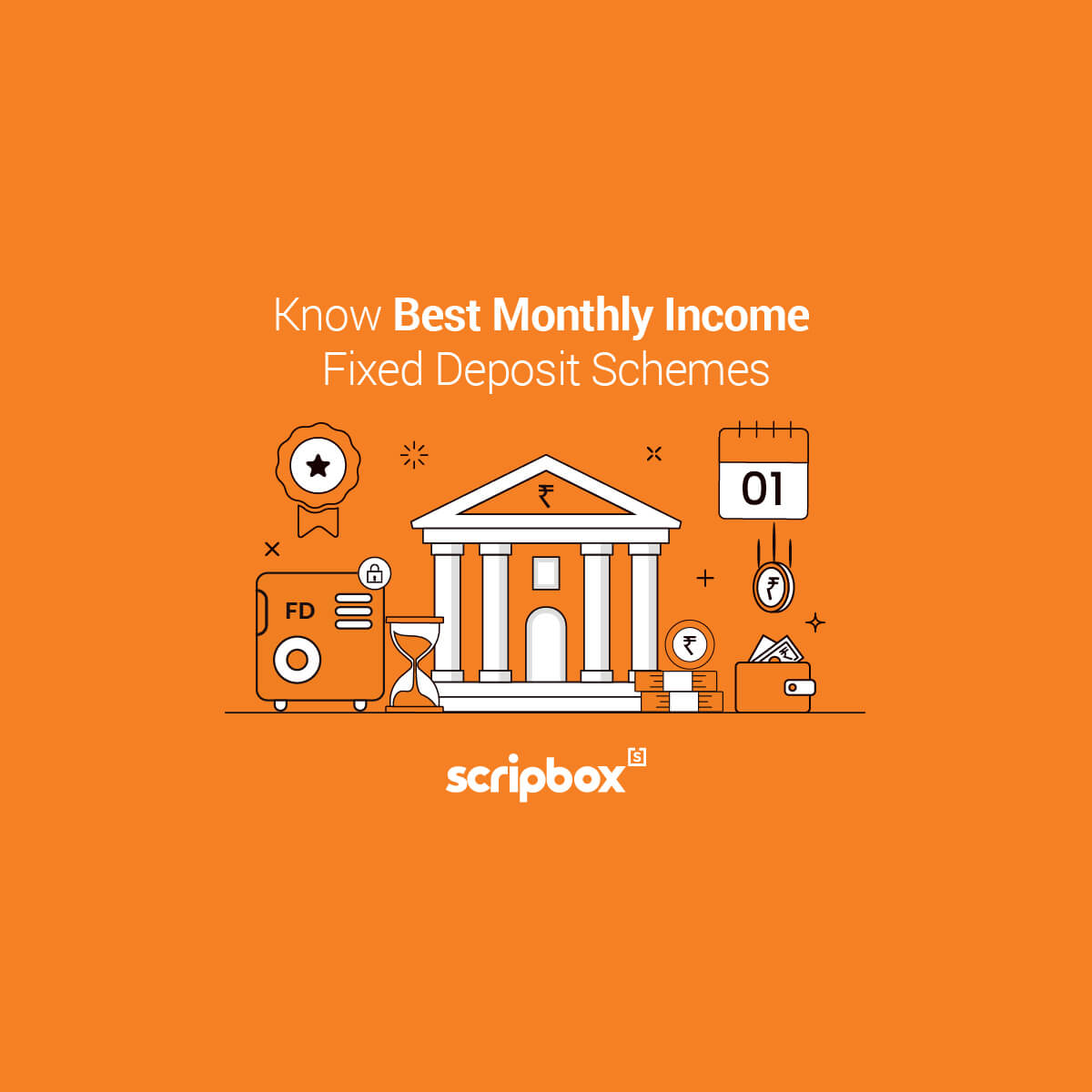Often we look for a steady source of income on a regular basis to ensure that we have a financially stable life. Moreover, such a source of income is desired by investors who are either retired or planning their retirement. In such a situation the course of action that an investor can adopt is to invest in a monthly income scheme. In this article, we can know about such schemes in detail.
What is a Monthly Income Scheme?
A monthly income scheme is an investment option wherein an investor invests a certain amount and receives the returns on such investment periodically. There are multiple types of monthly income schemes available like monthly income fixed deposit, SCSS, POMIS, SWP mutual funds. All such investment options have one thing in common i.e. a periodic withdrawal income. Each investment differs in terms of risk, features, terms, and conditions. These monthly payout schemes are either backed by the government or managed by a fund manager. Anyways, it is extremely easy and simple to invest in such schemes.
6 Best Monthly Income Plans
Following are the best monthly income schemes in India:
- Monthly Income Fixed Deposit
- Post Office Monthly Income Scheme
- SWP Mutual Funds
- Corporate Deposits
- Senior Citizen Savings Scheme
- Long-Term Government Bonds
1. Fixed Deposits with Monthly Payout
A fixed deposit is a very common and popular investment option among investors. As we all know a fixed deposit carries a lock-in period and interest income. When you invest in a monthly payout fixed deposit scheme the investment amount is locked for the FD tenure and the interest earned is provided to the investor. The investor can choose to opt for a regular payout of such interest income on a monthly, quarterly, half-yearly, or yearly basis. Such an FD is known as a non-cumulative fixed deposit. To know more about the monthly income FD scheme you can read our blog post on our website.
The following are a few features of monthly deposit fixed deposit:
- The interest rate is lower than that of a regular fixed deposit. the rate of interest which is offered for this type of FD is at a discounted rate.
- The minimum deposit amount varies from one bank to another, However mostly the minimum amount of deposit is Rs 10,000.
- A nomination facility is available
- Income tax is applicable at normal slab rates and taxable under the head ‘Income From Other Sources’
- Premature withdrawal is available with a penalty on such withdrawal.
- Due to periodic payout of interest income the effective interest earned is lower than a regular fixed deposit keeping the investment amount, tenure, and interest rate constant.
- Since the interest rate is predetermined and guaranteed by the bank it is a reliable and steady source of income for an investor looking for financial stability.
2. Post Office Monthly Income Scheme (POMIS)
The post office monthly income scheme is a government-sponsored scheme. As the name suggests it is offered and regulated by the Department of Post (DoP), Indian Post. The DOP, India Post reviews the interest rate every quarter. The interest rate depends on the returns yielded by the Government Bonds of the same tenure. POMIS interest rate is 7.40% p.a. for the current financial quarter. The monthly income is in the form of payout of the interest earned on the deposit. This scheme is better suitable for a low-risk tolerant (conservative) investor. Since the Government of India regulates the scheme the interest rate is guaranteed with a negligible scope of credit risk.
The following are the features of the post office monthly income scheme:
- You can invest in multiples of Rs 1,000 only. You can visit the official website of the Post Office to invest.
- The minimum amount of investment is Rs 1,000 while the maximum limit is Rs 9 lakh in a single account and INR 15 lakh in a joint account.
- If you don’t withdraw the interest accrued at the end of the month then no interest is calculated on such non-withdrawal interest. This means that the interest is applicable only on the principal amount and not on the accumulated balance in case of non-withdrawal. You can use POMIS calculator and estimate the monthly income.
- The interest income is taxable in the hands of the depositor. The investment amount does not qualify for any income tax deduction.
- You cannot make a premature withdrawal before the expiry of a period of 1 year from the date of the initial deposit.
3. Mutual Funds with Systematic Withdrawal Plans
A systematic withdrawal plan in mutual funds allows an investor to withdraw a fixed amount periodically. You can withdraw monthly, quarterly, half-yearly, or yearly. This scheme is completely flexible in terms of the amount and payout tenure selection. You can choose to withdraw a fixed amount or the capital gains on the mutual funds. The benefit or an attraction factor for SWP is that an investor can withdraw and stay invested in mutual funds at the same time. SWP ensures that the goal can be accomplished with no cash crunch, as, in fluctuating markets, the NAV of the mutual fund scheme is affected.
You can use SWP calculator and calculate the future value and total return. Scripbox’s SWP calculator is an easy-to-use online tool that helps you in estimating. All you need to do is enter the total deposit amount, tenure, withdrawal amount, frequency of withdrawals, and expected returns. The calculator will provide the total returns and the future value of the investment.
4. Corporate Deposits
The Non-Banking Financial Institutions (NBFC) in India offer corporate deposits or company deposits. The interest rate is higher than the regular fixed deposits offered by the banks. The corporate deposits are highly liquid. The interest in credited either quarterly or half-yearly as agreed between the investor and the NBFC. Similar to the fixed deposits with banks, the interest rate on a corporate deposit is predetermined and guaranteed. Moreover, the interest rate for senior citizens is higher than the interest rate for other citizens.
However, before investing make sure you check the credit rating of the NBFC provided by ICRA & CRISIL. You must invest in companies with adequate creditworthiness. Moreover, the corporate deposits are not insured under the DICGC. Hence, the credit rating becomes an important factor to consider before investing.
5. Senior Citizen Savings Scheme
A senior citizen savings scheme (SCSS) is a post office savings scheme designed to provide financial stability and regular income to senior citizens in India. Since the scheme is a post office savings scheme it is backed by the Government of India making a very low-risk investment option to plan regular income post-retirement.
The following are the features of the senior citizen savings scheme SCSS:
- From 1st Jan 2023, the interest rate is 8.20% p.a.. The interest is payable from the date of deposit of 31st March/30th Sept/31st December in the first instance & thereafter, interest shall be payable on 31st March, 30th June, 30th Sept, and 31st December.
- The minimum amount of deposit is Rs 1,000 while the maximum an investor can invest is Rs 15 lakh in multiples of Rs 1,000.
- A resident senior citizen above the age of 60 years can open the account. Such a senior citizen can open the account in his/ her individual capacity or jointly with the spouse only.
- An income tax deduction under section 80C of the Income Tax Act, 1961 is available for deposit amount.
- No interest is payable on the accumulated interest amount not withdrawn. For example, let us say you earned Rs 1,000 as interest for the financial year 2019-20. Going forward interest rate will be applied only to the deposit amount and not the accumulated amount due to non-withdrawal.
- You can close the account at any time after the opening of the account. However, if you close before 1 year then no interest will be payable. Further, even if the interest is paid and credited to the account, it will be recovered from the principal amount.
6. Long-Term Government Bonds
As the name suggests a long-term government bond is a debt instrument issued by the Central Government and/ or the State Government. The intent is to finance the economical and financial needs of the country and to regulate the supply of money. These bonds are issued under the supervision of the Reserve Bank of India. The duration of the bonds ranges from 5 years to 40 years. The interest rate on these G-Sec Long term bonds is known as a coupon rate or yield.
The different types of bonds are treasury bills, cash management bills, dated government securities, fixed-rate bonds, zero-coupon bonds, capital index bonds, inflation index bonds, sovereign gold bonds, STRIPs, etc. These bonds offer a stable interest rate, lower risk, liquidity to buy and sell in the open financial market. Additionally, RBI mandates that the interest accrued must be disbursed to the investors every 6 months.
While this long-term government no doubt benefits an investor, it has its own disadvantages as well. The yield or interest earned is relatively lower in comparison to other investment options like equity, real estate, corporate bonds, etc. Furthermore, since the maturity ranges from 5 years to 40 years the interest rate can be less attractive due to the rise in inflation in the country. The higher the bond period, the market risk increases with the interest rate risk.
Why should you invest in a Monthly Income Plans?
A monthly source of income not only provides stability and a free hand to spend but also independence. Depending on the monthly needs today and in the future, you must select the right investment option. The selection of the best-suited investment option depends on your investment goal, the interest rate offered by the investment option, tenure, and risk. Building a monthly income portfolio can benefit you in the following ways:
- As already discussed a regular income is of great importance to an individual with a limited source of income or limited capacity to work. For example, a senior citizen who is planning to retire should opt for a monthly income scheme to maintain the standard of living and meeting the expenses. A lump sum investment can keep this large sum secured for emergencies. While the regular income on such lumpsum amount will help meet the regular expenses.
- An investment in monthly income schemes also provides an added benefit of tax deduction under section 80C of the Income Tax Act, 1961. You can claim a deduction for an amount up to Rs 1.5 lakhs. The tax deduction is available for senior citizens savings scheme, long-term government bonds. However, the post office monthly income scheme, corporate deposits, SWP mutual funds, and monthly deposit fixed deposits do not qualify for any income tax deduction.
Check Out Types of Banks Accounts in India
Importance of a Monthly Income Generation Plan
A monthly income generation plan is a crucial element in financial planning. It offers a consistent income flow, supporting daily expenses, and facilitating savings for future objectives. And, also establishing a financial safety net for unforeseen circumstances.
The main advantage of a monthly income investment plan lies in its stability and predictability. A fixed monthly income makes it possible to cover essential costs like rent, utility bills, and groceries. This stability helps prevent financial stress and focus on other goals.
Moreover, the best monthly income investment plan is a passive income source, supplementing or even replacing salaries or business earnings. It plays a vital role in achieving financial independence and early retirement, contributing to an enhanced quality of life.
Thus, the best monthly income investment plan is a fundamental tool for financial planning, offering the necessary financial security and stability.
What to Consider Before Buying Monthly Income Plans?
The following are some factors to consider before investing in monthly income plans:
- Investment Objective: Pick a plan on the basis of your investment objective. For example, if you are looking for long-term growth, regular income, or a combination of both.
- Risk Appetite: Assess your tolerance for risk and select an investment option that aligns with your risk profile.
- Returns: Though historical returns do not guarantee future returns, it is a good parameter to estimate the performance of a scheme. Thus, examine the historical performance and returns of the investment option before purchasing.
- Investment Horizon: You need to define your investment horizon before picking a scheme. Opt for a plan that aligns with your specific investment goals.
- Tax Implications: Tax plays a significant role in determining your returns. Evaluate the tax implications and opt for an investment option that provides tax benefits.
- Fees and Charges: High fees and charges may lower your overall returns, thus, pick options that have lower fees and charges.
- Liquidity: Consider the liquidity of the investment option and choose one that suits your investment needs. Liquidity matters the most in case of uncertainty. Thus, pick options that have flexible exit options.
Best Time to Buy a Monthly Investment Plan
The best time to buy a monthly investment plan depends on your investment goal and financial situation. If your goal is to generate monthly income, then now is the best time to invest. It is always advisable not to time the markets (as it’s not everyone’s ball game), and always approach investments based on your goals.
- What is a Monthly Income Scheme?
- 6 Best Monthly Income Plans
- 1. Fixed Deposits with Monthly Payout
- 2. Post Office Monthly Income Scheme (POMIS)
- 3. Mutual Funds with Systematic Withdrawal Plans
- 4. Corporate Deposits
- 5. Senior Citizen Savings Scheme
- 6. Long-Term Government Bonds
- Why should you invest in a Monthly Income Plans?
- Importance of a Monthly Income Generation Plan
- What to Consider Before Buying Monthly Income Plans?
- Best Time to Buy a Monthly Investment Plan















Show comments